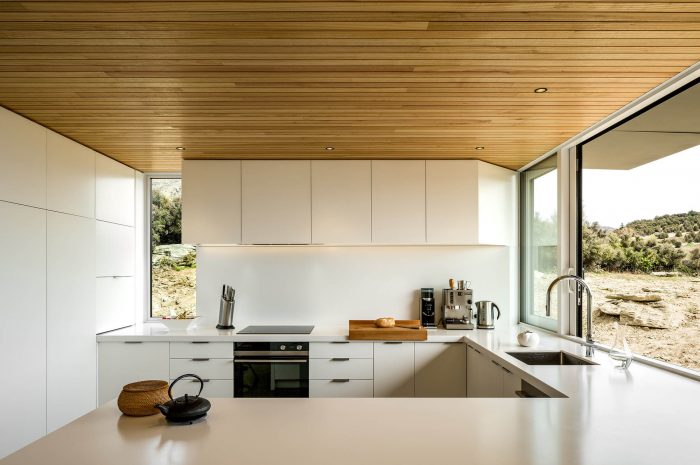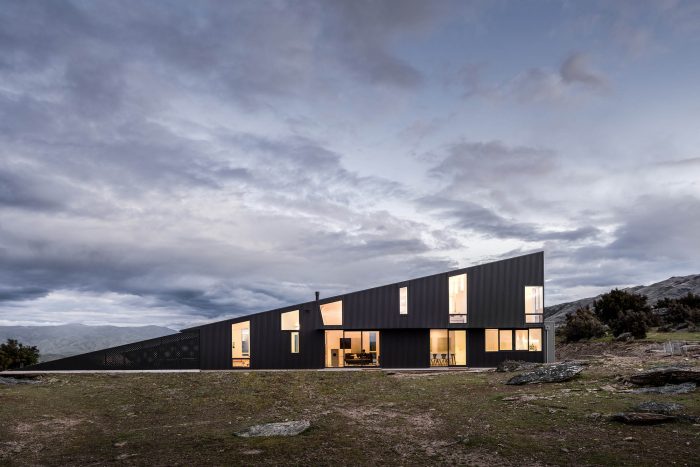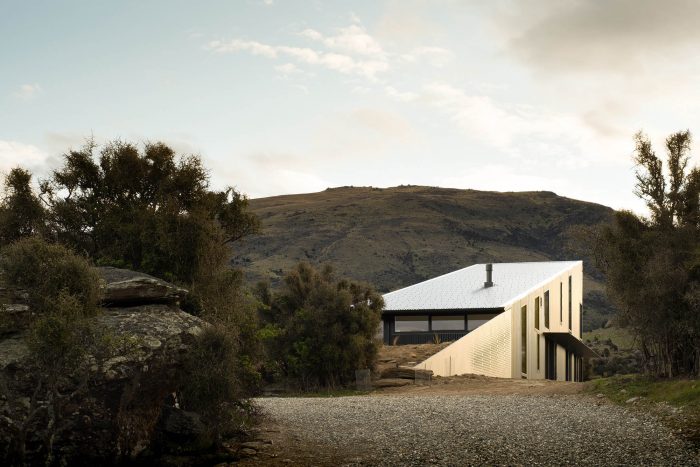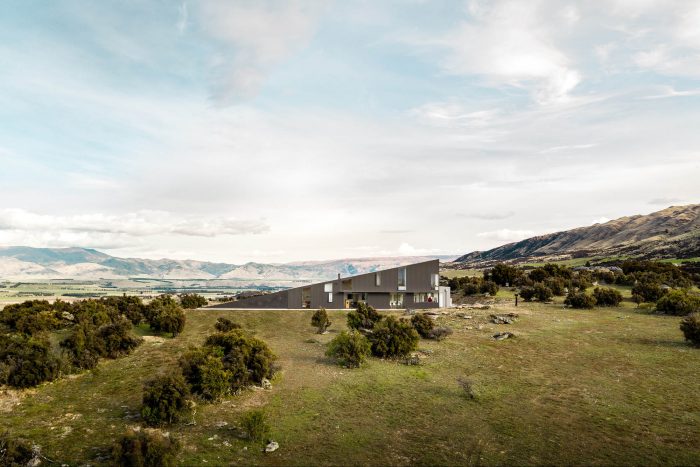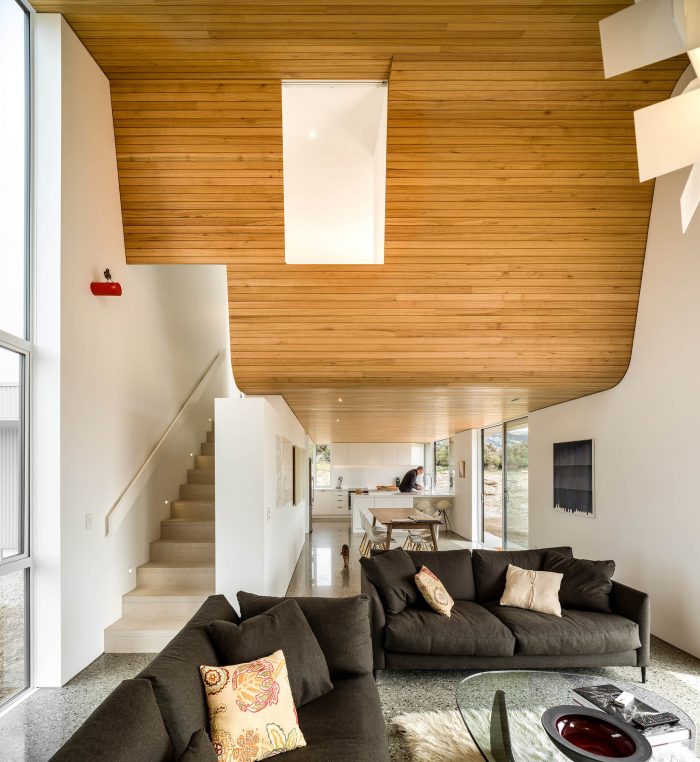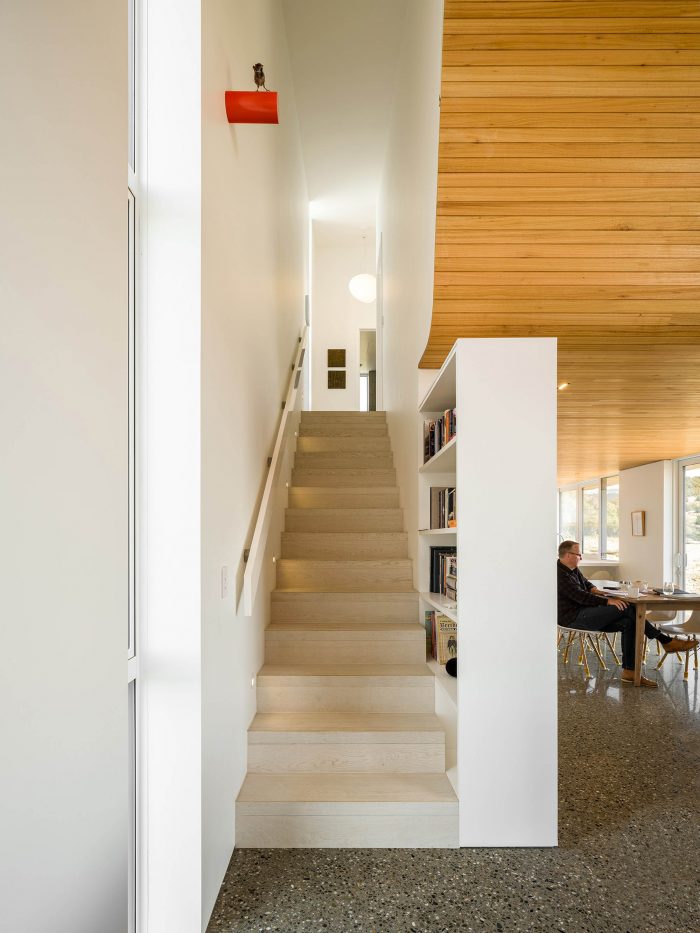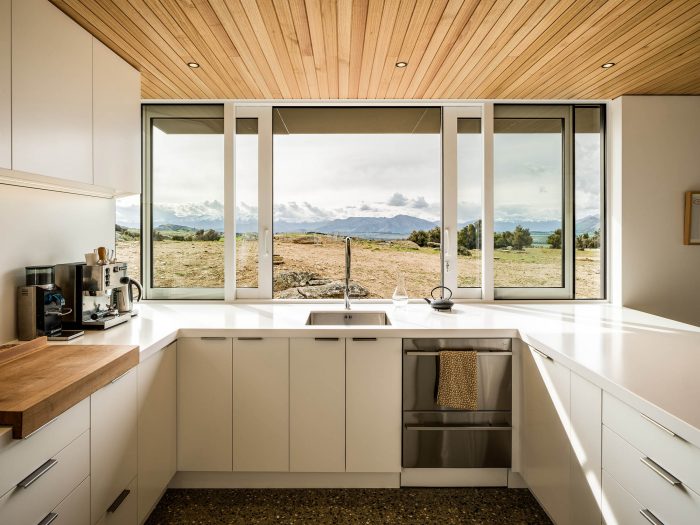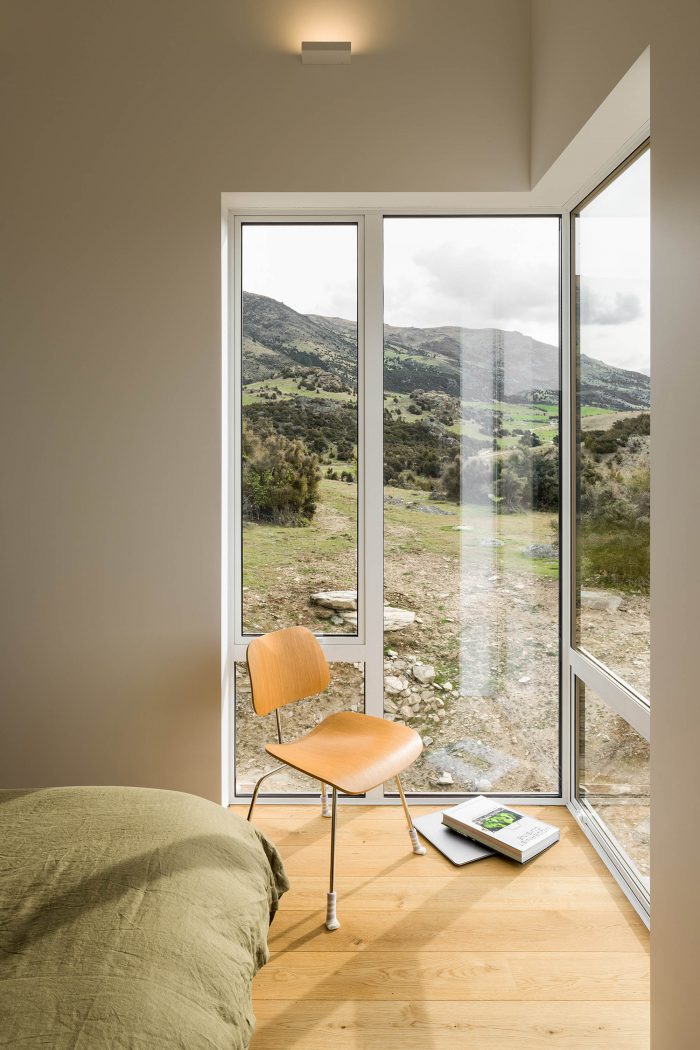Wanaka Wedge House三居室位于新西兰南岛一个面向南阿尔卑斯山的孤立山脊上,与奥塔哥中部戏剧性的景观相得益彰。几何原始的外部形式掩盖了复杂而有趣的内部结构。不对称的窗户摆放位置与房子的简单形状形成鲜明对比,以应对景观和内部空间的特定比例。主屋 “楔子 “的外部用深灰色的波纹金属板包覆,呼应了当代新西兰的乡土气息。对比鲜明的车库和酒窖的立方体则用浅灰色金属板和相匹配的屋顶膜进行包覆。
Located on an isolated ridge facing the Southern Alps on New Zealand’s South Island, the 3-bedroom Wanaka Wedge House complements the dramatic Central Otago landscape. The geometric-primitive exterior form belies a complex and playful interior. Asymmetric window placement contrasts the simple shape of the house to respond to views and specific proportions of the interior spaces. The exterior of the main house ‘wedge’ is clad in dark gray, corrugated metal panels echoing the contemporary New Zealand vernacular. The contrasting cube of the garage and wine cellar is clad in light gray metal with a matching roof membrane.
这两种颜色都必须通过严格的规划和设计准则,规定反射率和色调的限制。在室内,由当地种植的桉树定制的表面包裹着某些地板、墙壁和天花板,在主题上将公共和私人空间分开,并赋予室内温暖和维度。滑动板、盲门和隐蔽的硬件提供了意想不到的内部连接。白色的墙壁突出了当代艺术收藏,材料与简单的揭示相遇。原生的草和植物正在逐渐恢复这个前羊群站的景观。
Both colors had to pass strict planning and design guidelines specifying limits on albedo and hue. On the interior, a surface of custom-milled, locally-farmed Eucalyptus wraps certain floors, walls, and ceilings to thematically separate public and private spaces and lend warmth and dimension to the interior. Sliding panels, blind doors, and concealed hardware afford unexpected interior connections. White walls highlight a contemporary art collection and materials meet with simple reveals. Native grasses and plants are gradually restoring the landscape of this former sheep station.
业主是成就斐然的国际音乐家(一位指挥家和一位小提琴家),对他们来说,在设计的各个方面的精致和精确是至关重要的。对于这对夫妇来说,Wanaka Wedge House是他们繁忙的现代古典音乐生活中的一个避难所。这里是他们精进手艺、烹饪、享受当地葡萄酒、阅读、听音乐、展示大量新西兰当代艺术收藏品以及沉思该国最引人注目的景观之一的地方。
The owners are accomplished international musicians (a conductor and a violinist) for whom refinement and precision in all aspects of design are of critical importance. For this couple, the Wanaka Wedge House is a sanctuary at the center of their busy lives in contemporary classical music. It is a place to refine their craft, cook, enjoy local wines, read, listen to music, showcase an extensive collection of contemporary New Zealand art, and contemplate one of the country’s most dramatic landscapes.
最令人惊讶的是这个家的诞生过程。楔形屋是建筑师设计的原型的一个变体,可以根据不同的地点进行调整,起源于缅因州海岸的一个地点。在这里,场地的特殊性被重新考虑为原型与场地的合适匹配:通用形状作为场地调整后的建筑。对于业主来说,原型设计及其已经完成的设计开发图是一种节约成本的措施。在这个过程中,建筑师是产品的开发者和现场调整者。建筑师在选址、原型修改、成品细部设计和施工的整个过程中都担任设计顾问。
Most surprising is the process by which this home came to be. The Wedge House is a variant of a prototype designed by the architects to be adjusted for different sites, originating at a location on the coast of Maine. Here, site-specificity is reconsidered as the suitable matching of a prototype to site: generic shape as site adjusted architecture. For the owners, the prototype design with its already-completed design development drawings was a cost-saving measure. In this process, the architect is a product developer and site adjuster. The architect served as a design consultant throughout the process of site selection, prototype modification, finish detailing, and construction.
材料和系统的选择是为了达到可持续发展的目标,并满足突出当地饰面和手工艺的设计目标。建筑师将原型的SIP墙体替换为LVL木材的超级隔热木框架结构,以避免耗能的进口材料。抛光的混凝土热质底层(采用当地河石骨料)在冬季采用高效的水力辐射系统供暖。
Materials and systems were selected to meet sustainability targets and to satisfy design goals highlighting local finishes and craftspeople. The architects replaced the SIP walls of the prototype with a super-insulated wood-frame structure of LVL lumber to avoid the energy-intensive importation of materials. The polished concrete thermal-mass ground floor (featuring local river-stone aggregate) is heated in the winter with an efficient hydronic radiant system.
木结构的上层也包括托梁之间的辐射热。狭长房屋对面的窗户在大多数日子里提供自然通风,而位于 “楔形 “顶部的全屋风扇可以排出热量,并从阴凉的底部庭院抽出冷空气。热性能超过了新西兰单户住宅的标准。
The wood-framed upper floor also includes radiant heat between joists. Windows on opposite sides of the narrow house afford natural ventilation during most days while a whole-house fan at the very top of the “wedge” can evacuate heat and pull cool air from the shaded bottom courtyard. Thermal performance exceeds New Zealand standards for a single-family house.
建筑师:Actual Architecture
面积:2575平方米
年份:2019年
摄影:Dennis Radermacher
制造商:Escea, Fisher & Paykel, Foscarini, Colorcote, Easiroll, Haro Flooring, John Fairweather Specialty Timbers, Newtech
设计负责人:Jeffrey L. Day
项目团队原型设计:Jeff Davis
项目组修改设计:Dennis Krymuza
施工文件/许可证:Ian Perry
建筑工程师:ichards Consulting Engineers
总承包商:Matthew Colebrook Colebrook & Co. Ltd.
木材供应商:John Fairweather Specialty Timber Solutions
国家:新西兰
Architects: Actual Architecture
Area: 2575 m²
Year: 2019
Photographs: Dennis Radermacher
Manufacturers: Escea, Fisher & Paykel, Foscarini, Colorcote, Easiroll, Haro Flooring, John Fairweather Specialty Timbers, Newtech
Design Principal:Jeffrey L. Day
Project Team Prototype Design:Jeff Davis
Project Team Revised Design:Dennis Krymuza
Construction Documents / Permit :Ian Perry
Building Engineer:Richards Consulting Engineers
General Contractor:Matthew Colebrook Colebrook & Co. Ltd.
Wood Supplier:John Fairweather Specialty Timber Solutions
Country:New Zealand










